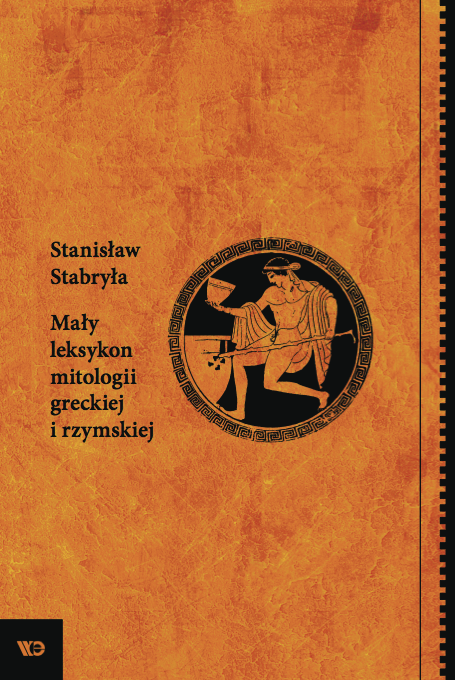Title of the work
Country of the First Edition
Country/countries of popularity
Original Language
First Edition Date
First Edition Details
Stanisław Stabryła, Mały leksykon mitologii greckiej i rzymskiej. Kraków: Wydawnictwo Edukacyjne, 2006, 365 pp.
ISBN
Genre
Glossary
Myths
Target Audience
Crossover (children, teenagers, young adults)
Cover

Scan of the cover kindly provided by Wydawnictwo Edukacyjne.
Author of the Entry:
Summary: Helena Płotek, University of Warsaw, helenaplotek@student.uw.edu.pl
Analysis: Marta Pszczolińska, University of Warsaw, m.pszczolinska@al.uw.edu.pl
Peer-reviewer of the Entry:
Katarzyna Marciniak, University of Warsaw, kamar@al.uw.edu.pl
Elżbieta Olechowska, University of Warsaw, elzbieta.olechowska@gmail.com

Photograph courtesy of the Author.
Stanisław Stabryła
, b. 1936
(Author)
Classical philologist, retired professor of the Jagiellonian University. Author of numerous publications on ancient culture and Latin literature of the Augustan Age. His scholarly interests encompass Roman and Christian literature and the reception of Antiquity in Polish literature. His most notable and popular works include: Hellada i Roma w Polsce Ludowej. Recepcja antyku w literaturze polskiej w latach 1945–1975 [Hellada and Roma in the People’s Republic of Poland. Reception of Antiquity in Polish Literature Between 1945 and 1975], 1983; Mitologia dla dorosłych [Mythology for Grown-ups], 1995; Klątwa Pelopidów [The Curse of the Pelopids], 1995; Hellada i Roma. Recepcja antyku w literaturze polskiej w latach 1976–1990 [Hellada and Roma. Reception of Antiquity in Polish Literature Between 1976 and 1990], 1996; Księga legend rzymskich [The Book of Roman Legends], 1998; Dzieje wojny trojańskiej [The History of the Trojan War], 2004, and Terroryści znad Tybru [Terrorists from the Tiber’s Shores], 2006. Translator of ancient texts such as Seneca’s Thoughts or Ovid’s Metamorphoses (translated with Anna Kamieńska). Member of Polska Akademia Umiejętności [Polish Academy of Arts and Sciences], Polski PEN Club [Polish PEN Club] and Polskie Towarzystwo Filologiczne [Polish Philological Society].
Sources:
[The Author’s Website], (accessed: March 14, 2013).
"Wspomnienia profesora Stanisława Stabryły", http://www.archiwum.uj.edu. pl/stanislaw-stabryla (accessed: March 14, 2013).
Bio prepared by Katarzyna Sendecka, University of Warsaw, katarzyna.sendecka@student.uw.edu.pl
Sequels, Prequels and Spin-offs
Stanisław Stabryła, Słownik szkolny. Mitologia grecka i rzymska, Warszawa: Wydawnictwa Szkolne i Pedagogiczne, 1994, 224 pp.
Summary
Based on: Katarzyna Marciniak, Elżbieta Olechowska, Joanna Kłos, Michał Kucharski (eds.), Polish Literature for Children & Young Adults Inspired by Classical Antiquity: A Catalogue, Faculty of “Artes Liberales”, Warsaw: University of Warsaw, 2013, 444 pp.
This lexicon includes over 1,000 entries ranging from proper names and characters to beasts and myths from Greek and Roman mythology. Stabryła touches upon famous legends like those about Hercules or Oedipus but does not forget the lesser-known ones. Occasionally, a few versions of the same myth are presented. The lexicon offers Greek and Roman gods’ names – for example, Aphrodite and Venus. Still, only the Greek entries contain a full description. In the foreword, the author underlines this fact stating that there are more sources for Greek myths. Near the end of each entry, the author shows how the character evolved – citing various works by other authors (for example, paintings and plays) where the characters were referenced or used. Stabryła also cites many Polish examples of such works allowing the young reader to find the information they may need. The author focuses on Greek and Roman mythology because he considers that the Greek and Roman heritage influenced European culture for centuries in a most significant way. The entries fall into different categories: characters entries – e.g., Hera and Poseidon, places and lands: e.g., Troy, Olympus, or the Elysian Fields. A few entries deal with personifications, Greek or Roman holidays and festivals, the Olympic or Panathenaic games. Explanations of terms, such as aegis or ambrosia, fall into a separate category. All entries are explained clearly and concisely, making the publication ideal for younger readers. To break the natural monotony of the lexicon, the author adorned it with occasional illustrations. They may show black- or red-figure vases or pictures showing Greek themes. A glossary of complex and key terms, such as agora or amphora, has been placed at the end of the lexicon. This indicates the desire to facilitate the use of the book for younger readers.
Analysis
In a short preface, the author reveals his editorial goal and attitude towards Greek myths. His mission is to present abundant and detailed information about Greek mythology. Out of necessity, to reduce the volume of the book, he had to select only the main, basic versions of the well-known myths. Eventually, a thousand entries were selected in the order of their relevance to understanding the cultural phenomena of European culture. The entries present singular and plural/collective characters (Cyclopes, Epigonoi, Geniuses [genii], Musae, Nymphs), mythical places, personifications, festivals and other issues. As for the order of the entries and their setup, the lexicon is very similar to the previous edition, published under the title Słownik szkolny. Mitologia grecka i rzymska, by WSiP – a textbooks and educational resources publisher. The entries included in the dictionary are almost identical to those prepared for the previous edition, with occasional minimal modifications.
The re-publication of the dictionary shows the constant need for such publications to help understand cultural phenomena of antiquity and contemporaneity. With a clear layout and solid content, this lexicon can be considered the best resource for that purpose.
Further Reading
[The Author’s Website], (accessed: March 9, 2022).
Gärtner, Hans, August Friedrich von Pauly, Walther Sontheimer, Konrat Ziegler, eds., Der Kleine Pauly. Lexikon der Antike, München: Druckenmüller, 1964–1975.
Grimal, Pierre, The Concise Dictionary of Classical Mythology, ed. Stephen Kershaw, trans. A. R. Maxwell-Hyslop, Basil Blackwell Ltd, 1990.
Irmscher, Johannes et al., eds., Lexicon der Antike, Leipzig: VEB Bibliographisches Institut, 1971.
Stabryła, Stanisław, “The Classical Culture in the Modern World", Classica Cracoviensia 18 (2021): 349–362 (accessed: December 9, 2021).
Styka, Jerzy, “Musarum cultor. Stanisław Stabryła: uczony, humanista, człowiek” in Jerzy Styka, ed., From Antiquity to Modern Times. Classical Poetry and its Modern Reception. Essays in Honour of Stanislaw Stabryla, Kraków: Księgarnia Akademicka, 2007.
Addenda
Cover, title page, typographics – Przemysław Dębowski.
Selection and preparation of the illustrations – Dominika Maliszewska-Filip.


